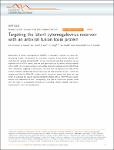Targeting the latent cytomegalovirus reservoir with an antiviral fusion toxin protein
Krishna, B. A.
Spiess, K.
Poole, E. L.
Lau, B.
Voigt, Sebastian
Kledal, T. N.
Rosenkilde, M. M.
Sinclair, J. H.
Reactivation of human cytomegalovirus (HCMV) in transplant recipients can cause life-threatening disease. Consequently, for transplant recipients, killing latently infected cells could have far-reaching clinical benefits. In vivo, myeloid cells and their progenitors are an important site of HCMV latency, and one viral gene expressed by latently infected myeloid cells is US28. This viral gene encodes a cell surface G protein-coupled receptor (GPCR) that binds chemokines, triggering its endocytosis. We show that the expression of US28 on the surface of latently infected cells allows monocytes and their progenitor CD34+ cells to be targeted and killed by F49A-FTP, a highly specific fusion toxin protein that binds this viral GPCR. As expected, this specific targeting of latently infected cells by F49A-FTP also robustly reduces virus reactivation in vitro. Consequently, such specific fusion toxin proteins could form the basis of a therapeutic strategy for eliminating latently infected cells before haematopoietic stem cell transplantation.
Files in this item
No license information

